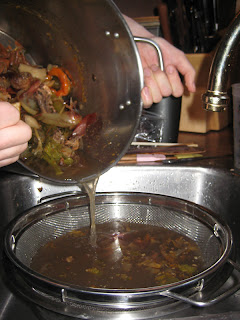I own a copy of Anthony Bourdain's Les Halles Cookbook which devotes a whole separate chapter to stock. I used to follow Bourdain's guidelines for his rustic "workmanlike stock" fit for country french cooking. Now I feel that maybe his a basic stock, if you compare it with the very posh stocks of chefs like Thomas Keller. But Bourdain has nothing on my regular down and dirty stock process. He does things like peel onions and carrots. And wash them. And removes celery leaves. And roasts his bones in a tomato paste and flour coating. And sticks to just the big classics: celery, carrot, onion and bouquet garni. And he strains and removes unsightly bits. Not me. I don't roast the bones because I'm reusing the bones from previous meals. I don't remove celery leaves...I save them and freeze them just so I can use them in stock. I love all the little bits and scraps. And I believe they make the best stock, better than the purist versions. Here's an incomplete list of what I save:
- carrot peels and ends
- celery stems and leaves
- onion skins and ends
- garlic paper
- the interior and tops of bell peppers
- corn cobs
- leftover bones of any sort
I save all of my bits and pieces in jars and bags and put them in the freezer. When I have enough it's time to make stock. I'm not picky. I don't do separate veggie stock and chicken and beef stock. It all goes in together.
Here it is in all its gloriousness in a big stock pot. You can also see sections of old turnips. I added some newer bits of onion, carrot, celery, and garlic because I had plenty of all of them laying around. In this one were bones from roasted chicken legs, bones from chicken wings, and some oxtail from a previous stock making that I judged still had more goodness to give. To all this I added 2 tablespoons of salt, a couple bay leaves, and a generous helping of "Italian herbs". (And a squirt of kechup. We didn't have a tomato paste open. The robustness of the tomato is nice in a stock. And the additional vinegar and sugar in kechup acts as an additional flavor enhancer.) Next it all gets covered with cold water. Then heat, low and for a long time. This one, because I didn't want to bother with it, sat on low for almost a full day. Finally you strain.
Nothing fancy. Just a colander set into a big bowl. You'll have to let it drain for awhile. You're left with tasty stock. It keeps for about 6 weeks in the fridge I'm told. Or you could pressure can it. Or freeze it. Since I don't like to have too many jars of stock taking up space in the fridge, I like to condense it. So I put the strained stock back on the stove and heat it on high to boil it down. I'm left with very useful concentrated stock.
You can use stock in just about every recipe that calls for water. You can use it for rice pilaf, for chili, for brining. Use it to make the best soups of course, or sauces or gravies. Having good stock is the #1 secret for making your home cooking more like restaurant cooking. Just be wary that there are a few things to don't go in stock. Cauliflower and broccoli are too strong. Cabbage can be OK if you don't cook it too long. Apple cores and the like are good, but I've never tried strawberry tops or banana peels. I've never done potatoes, but would think they soak up more flavor than they donate.
.jpg)


That all looks delicious. Having tried your stock, I can agree.
ReplyDelete...why would someone spend all that time doing something that fancy to something they were going to boil?